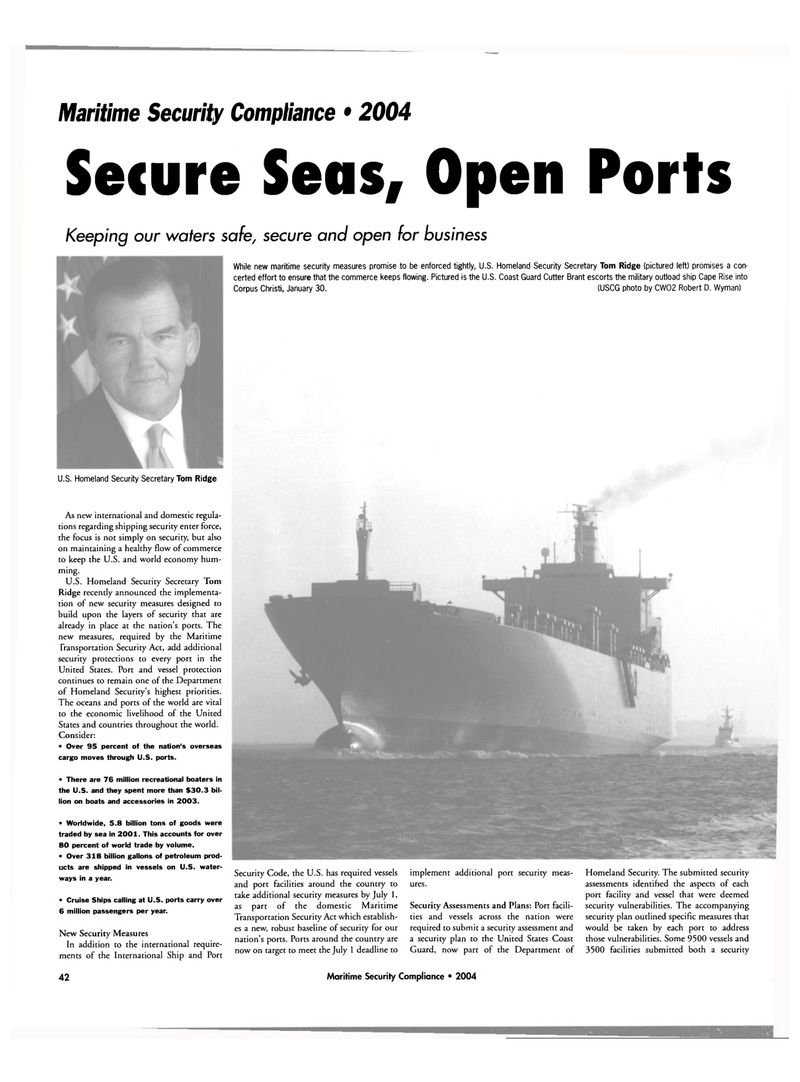
Page 42: of Maritime Reporter Magazine (July 2004)
Gulf of Mexico: Floating Production Systems & Support Vessels
Read this page in Pdf, Flash or Html5 edition of July 2004 Maritime Reporter Magazine
Maritime Security Compliance • 2004
Secure Seas, Open Ports
Keeping our woters safe, secure and open for business
While new maritime security measures promise to be enforced tightly, U.S. Homeland Security Secretary Tom Ridge (pictured left) promises a con- certed effort to ensure that the commerce keeps flowing. Pictured is the U.S. Coast Guard Cutter Brant escorts the military outload ship Cape Rise into
Corpus Christi, January 30. (USCG photo by CW02 Robert D. Wyman)
U.S. Homeland Security Secretary Tom Ridge
As new international and domestic regula- tions regarding shipping security enter force, the focus is not simply on security, but also on maintaining a healthy flow of commerce to keep the U.S. and world economy hum- ming.
U.S. Homeland Security Secretary Tom
Ridge recently announced the implementa- tion of new security measures designed to build upon the layers of security that are already in place at the nation's ports. The new measures, required by the Maritime
Transportation Security Act, add additional security protections to every port in the
United States. Port and vessel protection continues to remain one of the Department of Homeland Security's highest priorities.
The oceans and ports of the world are vital to the economic livelihood of the United
States and countries throughout the world.
Consider: • Over 95 percent of the nation's overseas cargo moves through U.S. ports. • There are 76 million recreational boaters in the U.S. and they spent more than $30.3 bil- lion on boats and accessories in 2003. • Worldwide, 5.8 billion tons of goods were traded by sea in 2001. This accounts for over 80 percent of world trade by volume. • Over 318 billion gallons of petroleum prod- ucts are shipped in vessels on U.S. water- ways in a year. • Cruise Ships calling at U.S. ports carry over 6 million passengers per year.
New Security Measures
In addition to the international require- ments of the International Ship and Port
Security Code, the U.S. has required vessels and port facilities around the country to take additional security measures by July 1, as part of the domestic Maritime
Transportation Security Act which establish- es a new, robust baseline of security for our nation's ports. Ports around the country are now on target to meet the July 1 deadline to implement additional port security meas- ures.
Security Assessments and Plans: Port facili- ties and vessels across the nation were required to submit a security assessment and a security plan to the United States Coast
Guard, now part of the Department of
Homeland Security. The submitted security assessments identified the aspects of each port facility and vessel that were deemed security vulnerabilities. The accompanying security plan outlined specific measures that would be taken by each port to address those vulnerabilities. Some 9500 vessels and 3500 facilities submitted both a security 42 Maritime Security Compliance • 2004

 41
41

 43
43
